Key takeaways
- Social contract theory emphasizes the balance between individual freedoms and social responsibilities, highlighting the trust placed in institutions and one another.
- Key philosophers like Hobbes, Locke, and Rousseau contribute diverse perspectives on human nature, authority, and collective agreement, challenging readers to consider the complexities of social contracts.
- In education, involving students in creating classroom norms fosters respect and shared responsibility, making rules feel like collective commitments rather than imposed restrictions.
- Addressing implicit consent and navigating historical injustices are critical challenges in teaching social contract theory, requiring open, honest dialogue to enrich the learning experience.
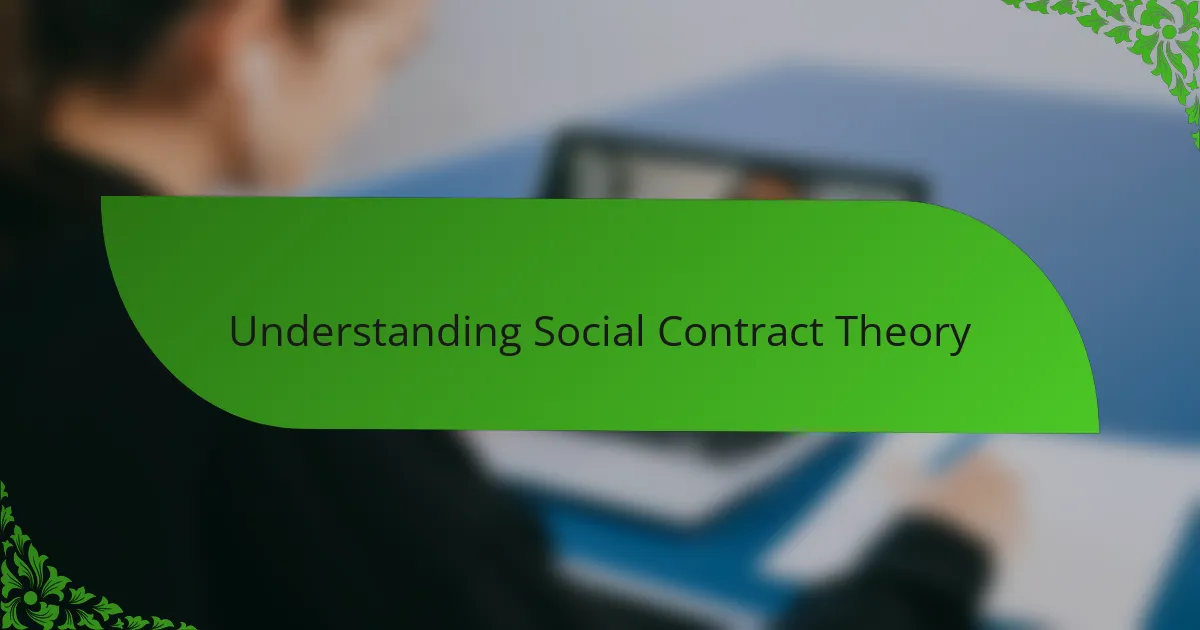
Understanding Social Contract Theory
When I first encountered social contract theory, I was struck by its simple yet powerful question: Why do we obey laws we didn’t personally agree to? This idea made me rethink society as a collective agreement, where our freedoms and responsibilities are balanced by mutual consent. It felt like uncovering the hidden rules that keep communities functioning smoothly.
Thinking about social contract theory, I’ve often wondered—what if no one consented? The theory suggests that living peacefully requires an implicit pact, but how explicit is that pact for each of us? This question pushed me to see social contracts not just as abstract ideas, but as living agreements we navigate every day.
In my experience, understanding this theory helped me appreciate the delicate trust we place in institutions and each other. It made me reflect on moments when this trust breaks down—how chaos can descend when the social contract is ignored or broken. Have you ever felt that tension between personal freedom and social responsibility? That’s the heart of social contract theory, and engaging with it made these tensions real for me.
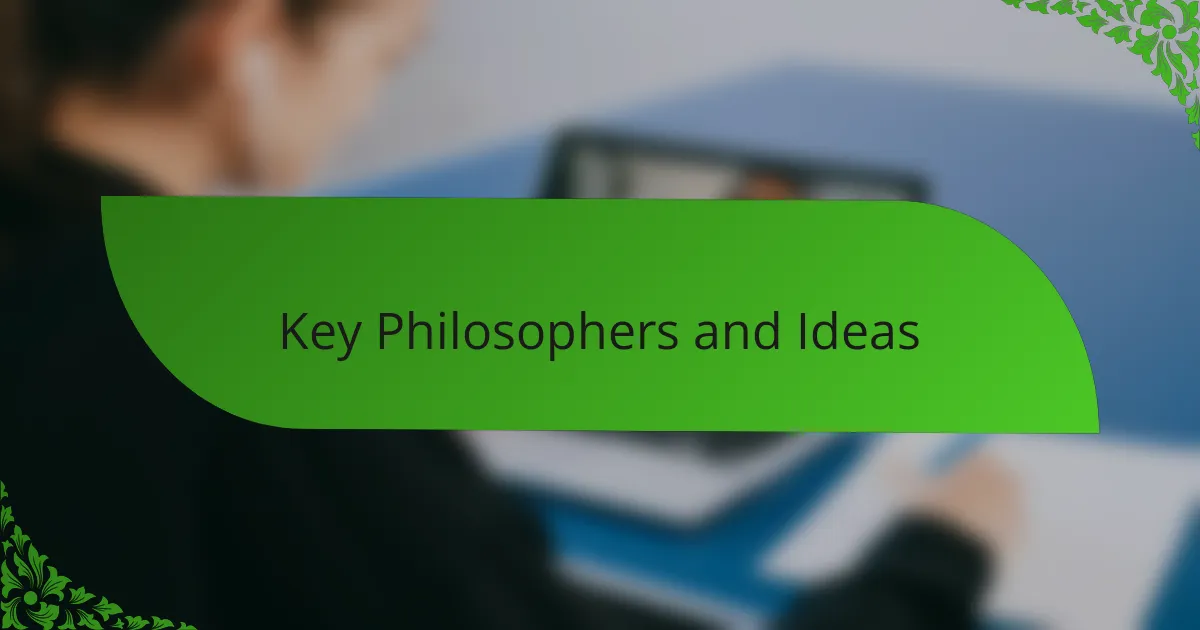
Key Philosophers and Ideas
When I first dived into the works of Thomas Hobbes, I was struck by his stark view of human nature—his belief that without a strong sovereign, life would be “solitary, poor, nasty, brutish, and short.” It made me reflect on whether strict authority is truly necessary for order or if there’s room for more trust among people. Hobbes’s idea that we trade some freedoms for security felt both unsettling and oddly comforting.
Then there’s John Locke, whose perspective felt like a breath of fresh air. His emphasis on natural rights and government as a protector rather than a ruler gave me hope that social contracts could be just and respectful of individual freedoms. I found myself asking, how do Locke’s ideas shape modern democracy, and do our governments live up to this vision?
Finally, Jean-Jacques Rousseau’s concept of the “general will” challenged my thinking the most. The idea that true freedom comes from obeying laws we prescribe to ourselves was both inspiring and confusing. Could collective agreement genuinely reflect individual desires, or does it risk silencing minority voices? Wrestling with Rousseau made me appreciate how complex and fragile these social agreements can be.
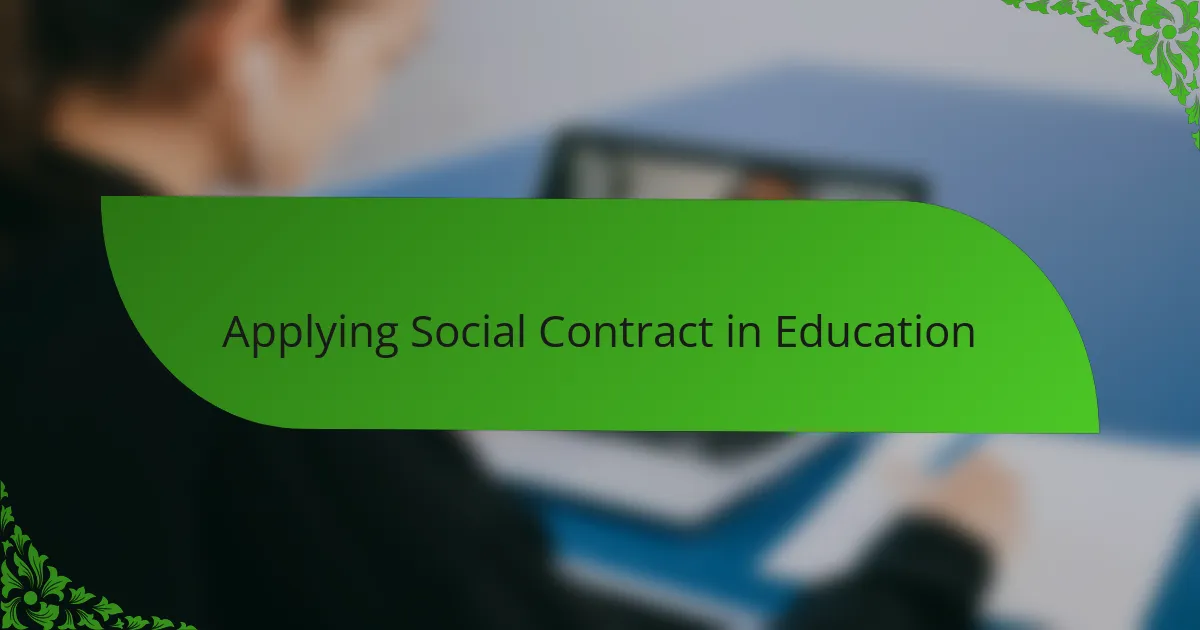
Applying Social Contract in Education
Applying social contract theory in education made me rethink how classroom rules aren’t just arbitrary mandates but agreements we all implicitly enter. When I started involving students in setting these norms, I noticed a shift—there was more respect and a real sense of shared responsibility. Have you ever tried letting students co-create their learning environment? It works wonders in turning rules into commitments rather than restrictions.
This approach also made me reflect on the balance between authority and freedom in education. I used to think strict enforcement was necessary, but embracing social contract principles showed me that when students understand the ‘why’ behind rules and see their role in them, engagement naturally improves. Isn’t it fascinating how trust and mutual consent can transform the classroom atmosphere?
At times, I struggled with disagreements—what happens when some students feel the rules don’t represent them? Here, Rousseau’s idea of the “general will” became a valuable lens. It reminded me that education, like society, must strive for agreements that reflect collective interests while being attentive to individual voices. Navigating this delicate balance is challenging but essential, and it keeps the social contract alive within learning spaces.
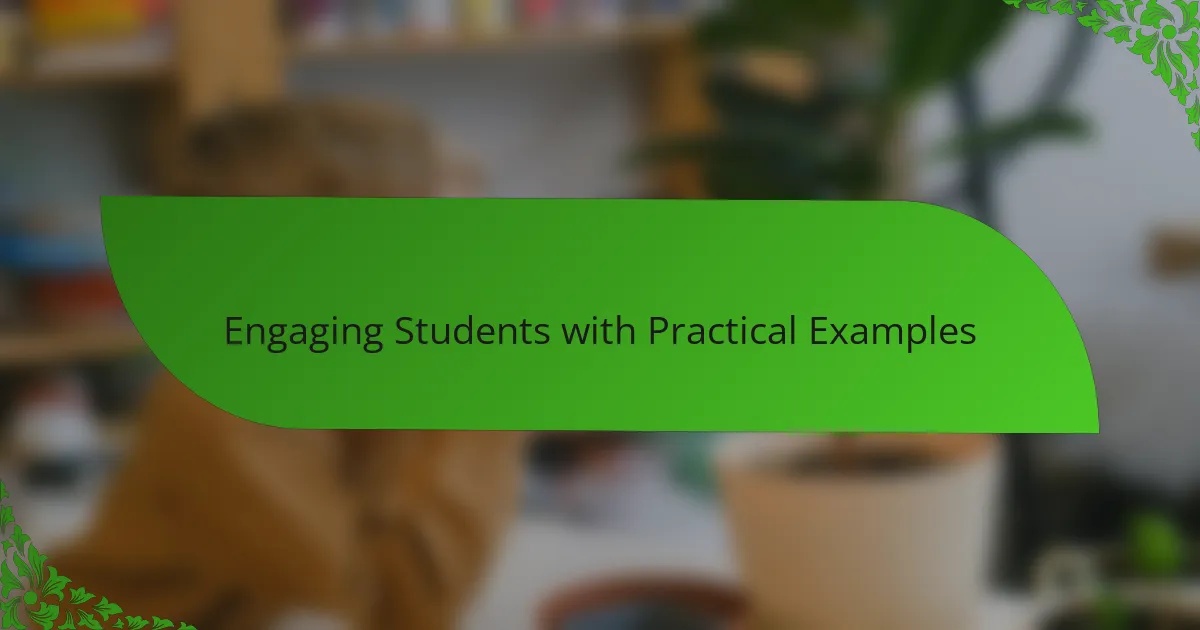
Engaging Students with Practical Examples
One way I’ve found practical examples bring social contract theory to life is by relating it to everyday situations like traffic laws or team sports rules. When students see how these agreements help maintain order and fairness in contexts they know well, the abstract ideas suddenly become tangible. Have you noticed how a simple game changes when someone ignores the rules? That’s a perfect gateway into discussing the consequences of breaking social contracts.
I also remember using a classroom role-play where students took turns negotiating changing a rule to benefit their group. Watching the discussions unfold, I saw firsthand how they grappled with balancing personal interests and the common good. It was fascinating to witness their growing awareness of compromise and consent in real time—it made the theory feel less like an academic concept and more like a lived experience.
Sometimes, sharing my own moments of frustration when social contracts felt broken—like when coworkers didn’t uphold shared agreements—helped students connect emotionally with the material. It opened up honest conversations about trust and expectations. Isn’t it interesting how our day-to-day interactions are reflections of these philosophical ideas? Bringing theory down to human experience truly deepens understanding.

Personal Reflections on Teaching Social Contract
Teaching social contract theory has been a journey of continuous discovery for me. I recall a particular class when a student challenged the whole idea by asking, “Why should I agree to a contract I never signed?” That question caught me off guard but became a turning point—it pushed me to explore deeper ways to connect the theory with students’ real feelings about consent and fairness.
There’s a certain vulnerability in admitting that I don’t have all the answers. Sometimes discussions get messy, as students bring up issues of power, exclusion, or historical injustices tied to social contracts. These moments remind me that teaching this theory isn’t just about conveying facts—it’s about guiding students through complex emotions and ethical dilemmas that have no easy solutions.
I often reflect on how this teaching experience has shaped my own understanding of social contract theory. It’s not a static idea but something living and evolving, just like the classroom relationships we build. Have you noticed how trust and dialogue can transform a group of strangers into a community? That transformation happens repeatedly when we unpack social contract theory together, and it’s genuinely rewarding to witness.
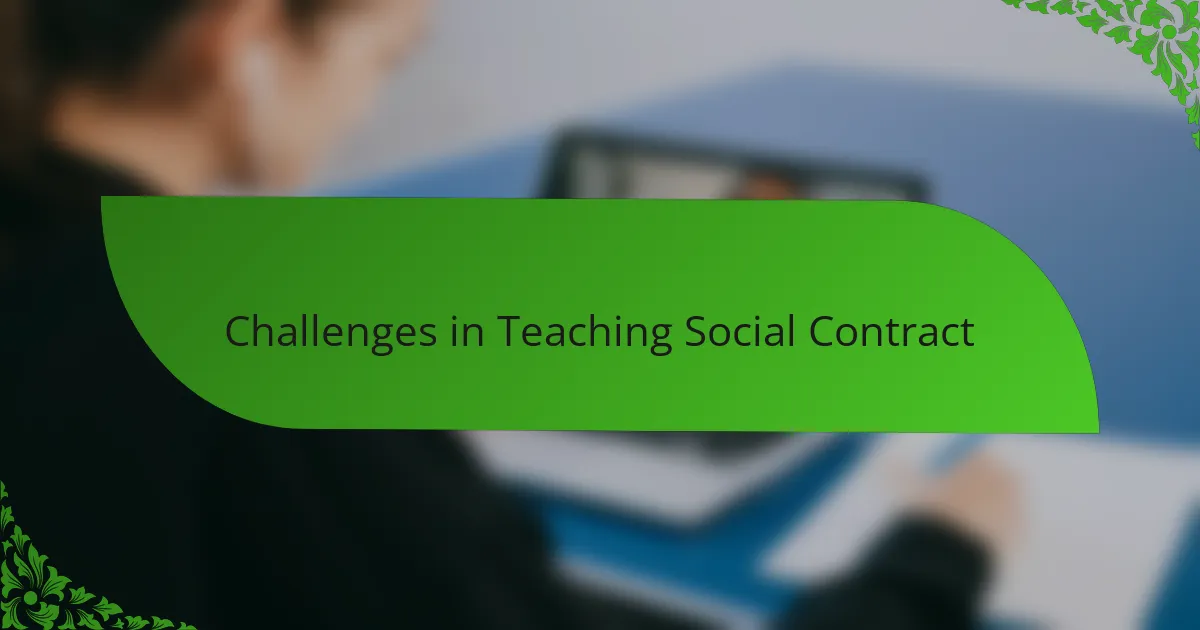
Challenges in Teaching Social Contract
One challenge I’ve faced in teaching social contract theory is helping students grasp the idea of implicit consent. Many ask, “How can we be bound by agreements we never explicitly agreed to?” Their skepticism is totally understandable—this question kept me thinking deeply about how to make abstract consent feel real and relatable.
Another hurdle is addressing the tension between individual freedoms and collective obligations. Students often struggle with the discomfort of giving up some autonomy for societal order. I remember a heated debate when a student passionately argued that the social contract sometimes feels like a trap rather than a fair exchange. It reminded me just how personal and emotional these ideas become once you start to live them rather than just read about them.
Finally, tackling the historical and cultural contexts behind social contracts can be tricky. Students bring up issues of exclusion, injustice, and power imbalances that the theory sometimes glosses over. Navigating these discussions requires patience and openness, but it also enriches the learning experience by showing that social contracts are not just philosophical ideals—they’re messy, evolving realities that impact real lives.
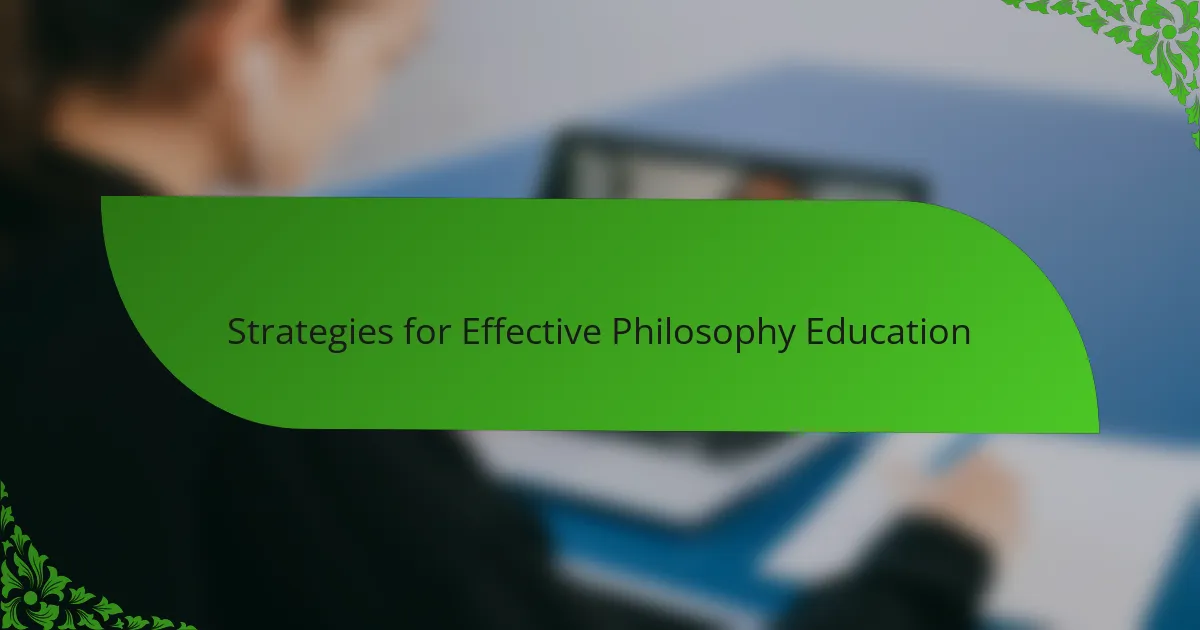
Strategies for Effective Philosophy Education
When I think about effective strategies for philosophy education, fostering active dialogue stands out as essential. Encouraging students to voice their curiosities and doubts makes abstract theories like the social contract come alive. Have you ever noticed how a question from one student can open doors for everyone’s deeper thinking? That dynamic exchange brings philosophy out of textbooks and into real human experience.
Another important approach I’ve found is contextualizing philosophical concepts with relatable examples. When I connect ideas to everyday decisions or current events, students seem to grasp the relevance more readily. Isn’t it striking how something as complex as social contract theory becomes clearer when linked to situations they encounter daily? This method bridges the gap between theory and practice in powerful ways.
Finally, creating a learning space where vulnerability is welcomed has transformed my teaching. Admitting uncertainties and embracing messy discussions helps students feel safe to explore challenging ethical questions. Have you ever seen how honesty about not having all the answers invites genuine curiosity? That openness transforms classrooms into communities of thinkers, which is exactly what philosophy education should be about.